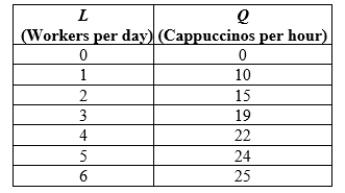Use the following to answer question:
Table 13.4 
-Table (13.4). Suppose that the wage rate for baristas is $9 per hour and the average price of cappuccino is $3.
a. Find the profit-maximizing quantity of labor.
b. What would be the new profit-maximizing quantity of labor if the market wage increased $12 per hour, ceteris paribus?
c. What would be the new profit-maximizing quantity of labor if the market wage remained at $9 per hour but the price of cappuccino increased to $4.50, ceteris paribus?
d. What would be the new profit-maximizing quantity of labor if the market wage remained at $9 per hour and the price of cappuccino at $3 but baristas all became 10% more productive because of an improvement in the way cappuccinos are made?
Definitions:
Test Statistic
In hypothesis testing, the test statistic is a standardized value derived from sample data, used to make a decision about the null hypothesis.
SPSS Output
The results generated by the Statistical Package for the Social Sciences, including statistical tests, tables, and graphs, after data analysis.
Test Statistic
A calculated value from sample data that is used in statistical testing to decide whether to reject the null hypothesis within the framework of a hypothesis test.
P-value
A statistical measure that indicates the probability of observing the test results, or something more extreme, if the null hypothesis is true.
Q1: Which of the following is NOT a
Q10: The price elasticity of demand for coffee
Q15: Operating leases often have terms that include<br>A)
Q22: Suppose that currently, 1 British pound equals
Q22: The game has two players, each with
Q29: Suppose 90-day investments in Britain have a
Q35: What is the option value of waiting?<br>A)
Q52: Explain how moral hazard could arise in
Q57: A monopolist serves market A with an
Q79: (Table 10.13) The table shows consumer valuations